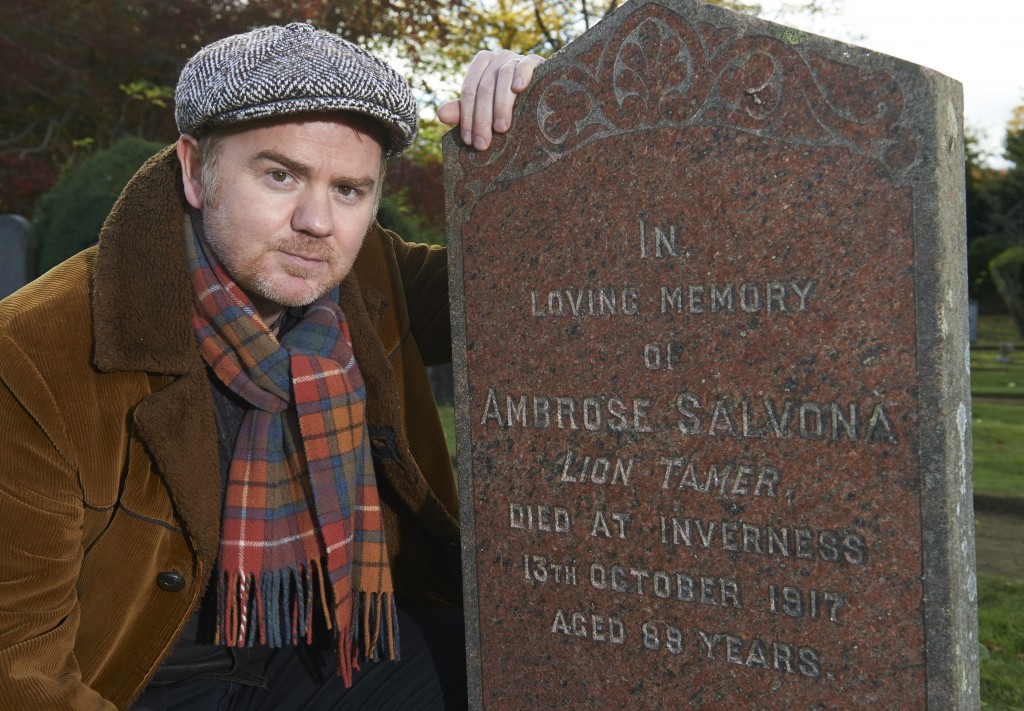
A song sung at a Perth music festival has led Edinburgh based singer-songwriter Dean Owens to make a poignant pilgrimage to an Inverness cemetery, to see for the first time the last resting place of his great great grandfather – the lair of the lion tamer.
Dean Owens wrote “Dora” – a track from his latest Nashville-recorded album “Into the Sea” – about his grandmother, Dora Salvona Owens, who grew up in a family circus in Scotland. He told the audience at Perth’s Southern Fried Festival, research into his family tree had revealed his great great grandfather Ambrose Salvona, who founded the circus, was a lion tamer and was buried somewhere in the Highlands.
Ambrose was thought to have come to this country from Italy in the company of a dancing bear, sometime in the late 19th century. The song refers to:
“Somewhere way back there’s a lion tamer/Ambrose and his dancing bear/He’s buried in the Highlands/but we’re not sure where.”
Now he knows – and a hundred year old mystery has been solved. Among Dean’s audience in Perth was a senior cultural manager with High Life Highland, Judi Menabney, whose organisation is responsible – among other things – for archives, registration and family history in Inverness.
Judi said: “Dean reckoned Ambrose was buried in Inverness, so I offered to see if I could track him down.”
On her return to Inverness, Judi told the story to some of her colleagues at the Highland Archive and Registration Centre (HARC), on the banks of the River Ness.
“They were really excited about the idea of finding Ambrose, she says, and they offered to see what they could find out.”
And, sure enough, the team soon discovered the lion tamer’s lair. Ambrose Salvona is buried in Tomnahurich Cemetery, a huge and beautiful burial ground not far from the river, sometimes known as “the Hill of the Fairies”.
The inscription on his tombstone simply reads “In Loving Memory of Ambrose Salvona. Lion Tamer. Died at Inverness 13th October 1917. Aged 88 years.”
And so enthused were the HARC team that they set out to find out more about the mysterious lion tamer. And, in scenes reminiscent of BBC television’s “Who Do You Think You Are”, they came up with a lot more information on the mysterious lion tamer.
“It was great fun investigating Ambrose’s story,” says family historian Anne Fraser. “He turns out to have been a very colourful character – which may not be a surprise – but we have also finished up raising as many questions as we’ve answered.”
What the team have established is that Ambrose was married twice, the father of at least ten children: that he was already around eighty when he came to Inverness, which would have been a major journey even for a young man, back then: and that he seems to have been a much loved character even in the time he spent in his new community apparently far from his family, in his autumn years.
At the end of his life, it’s now known he was admitted to the geriatric hospital facilities in what was then Inverness Poor House – it subsequently became Hilton Hospital and is now a block of residential flats – and died there, a few days later. A procession across the town took him to his final resting place, according to the death notice published in a local newspaper. He was “buried by friends”, according to cemetery records, in a prominent position at Tomnahurich.
But the questions remain. No explanation’s been found for why he travelled to the north in the first place. It’s not clear who the friends were who undertook the costs of his final burial. And, according to various records, he was said to have been born in London or France, though family traditions insist he came to this country from Parma in Italy.
“There’s still some detective work to be done on Ambrose’s story,” says Judi Menabney. “Many people don’t realise that this is a service we can offer, but it’s been a pleasure finding out what we could for Dean about his lion taming ancestor.”
Dean Owens – accompanied by his father, George – has now finally visited the grave where Ambrose was buried by his Inverness friends. “I can’t believe the final resting place of my great great grandfather has been found. I’m very grateful to Judi, Anne and their colleagues for all the work they’ve put into discovering his story,” he says. “I’m delighted they want to use it and my song Dora – which started the search – in their own presentations.”
“You really don’t know what’s up there, way up in the family tree. And maybe there’s another song in that”.
